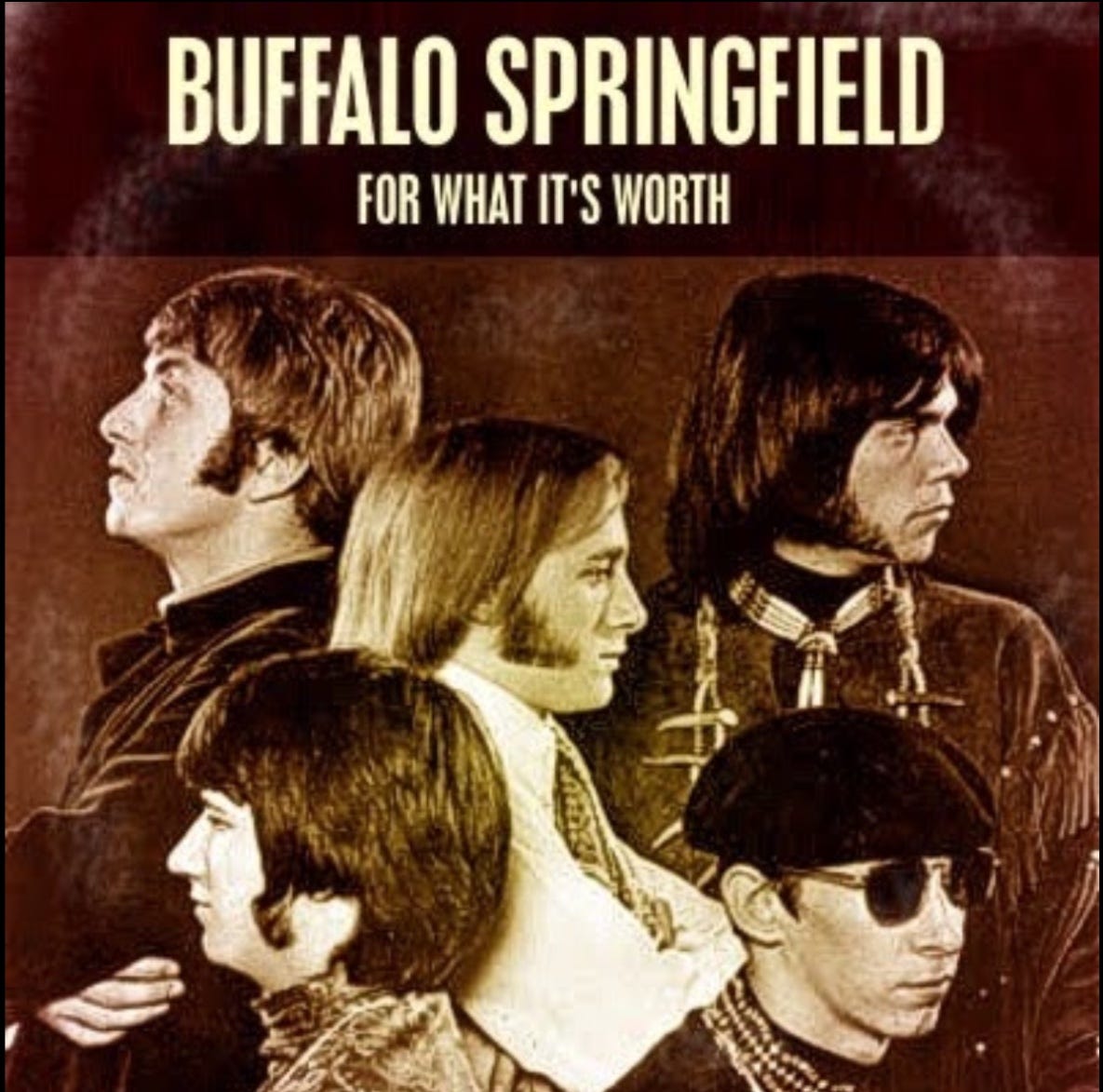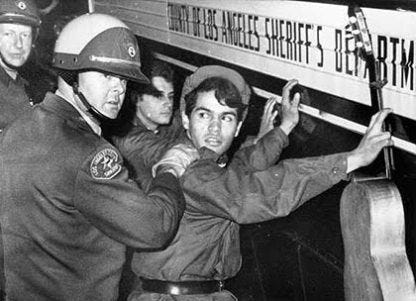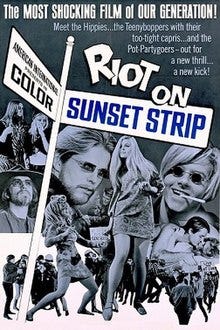"For What It's Worth (Stop, Hey What's That Sound)" by Buffalo Springfield (1966)
My favorite protest songs of the 60s and early 70s
This is the fourth in a series about my favorite protest songs from the sixties and early seventies.
We’ve already listened to three songs, in case you missed them:
“Blowin’ in the Wind” by Bob Dylan (1963)
“Masters of War” by Judy Collins (1963)
“Eve of Destruction” by Barry McGuire (1965)
I’ve also shared NickS’s post in response to the above asking “What makes a good protest song?” and giving his own list of favorites.
Today we listen to a song that is mistakenly assumed to be anti-war, when it’s actually about Hollywood and Sunset Boulevard and involves a couple of movie stars.
Protest song of the day
In 1970, Stephen Stills shared the story behind “For What It’s Worth,” his famous protest song for Buffalo Springfield, in an interview with UK music journalist, historian, and radio presenter Charlie Gillett for a program called Sounding Out1.
“‘For What It's Worth’ was a result of the fact that [I] was brought up partially in Latin America, and saw governments fall and rise and fall again. And, you know, dodged machine-gun bullets myself, because me and my dad were in a town, and everybody started shooting, and I was off hanging out and I was trying to get home, and it was one of those get back to the hotel alive kind of things… It was nitty gritty… That was when I was 14, 15 years old, right? Younger even.
“So I went back to America and everybody was really alive. And in Hollywood, California, the commercial merchants on Sunset Boulevard in a certain area decided that the element of young people that was on the street every night was not conducive to commercial enterprise. What actually happened was just a bunch of kids got together on a street corner and said we aren't moving. Then about three busloads of Los Angeles police showed up who look very much like stormtroopers, which is what the Guardia Civil in Nicaragua looks like. And I looked at it and I said, Jesus, America is in great danger of turning politically to the fascist right. ‘For What It's Worth’… it said hey, there's a revolution.”
Some background information might help here. Stephen Stills came from a military family that moved from one post to another during his childhood and adolescence, including stints in Costa Rica, El Salvador, and Panama. I’m guessing he was visiting Nicaragua with his dad in his mid-teens when they got caught up in a battle between the Guardia Civil and anti-Somoza revolutionaries — first-hand experience of what a revolution looks like when you’re right in the thick of it.
In November 1966, he would put that experience to good use as a songwriter in Buffalo Springfield. The band had only been together for about six months when the so-called curfew riots broke out on the Sunset Strip in Hollywood, California. Clubs and music venues along the Strip had been attracting crowds of youth, who annoyed the local residents and businesses by loitering around, making merry with drinking, drugs, and loud music, and, most egregiously, snarling up traffic.
The locals successfully lobbied the Los Angeles City Council for an anti-loitering ordinance that included a 10pm curfew. The Council took things even further and decided to force-purchase and demolish Pandora’s Box (see photo above), a popular nightclub and coffeehouse at one of the busiest intersections that had become the heart of the youth scene. The club was renowned and beloved for featuring performances by up-and-coming rock ’n’ roll musicians, including the Beach Boys, Sonny and Cher, and the Byrds.
The kids were not having this breach of their civil rights, nor the destruction of one of their favorite music venues and hangouts. They organized a protest outside Pandora’s Box by passing out leaflets up and down the Strip. The “rally” was also announced on L.A.’s rock stations, Pandora’s Box being owned by one of their own, disc jockey Jimmy O’Neill. The demonstration on the evening of Saturday, November 12th attracted close to a thousand protesters and also, as Stills mentioned, busloads of L.A. police officers in paratrooper-style uniforms that reminded him of the Guardia Civil.
Stills would later emphasize that “Riot is a ridiculous name, it was a funeral for Pandora's Box. But it looked like a revolution.”2
Among the demonstrators arrested and handcuffed by police that night was one Peter Fonda, there with his buddy Jack Nicholson. In less than two years, the two actors would star together in the unexpected blockbuster counterculture film Easy Rider, co-written and produced by Fonda and directed by Dennis Hopper, which would earn all three of them Oscar nominations and catapult their careers. It’s well worth watching the original trailer, which I think in just three minutes succeeds in conveying a flavor of the times and highlighting the tensions and issues that were creating a widening rift between the mainstream culture and the so-called youth “counterculture” that would only grow more intense in the years to come:
Film aficionados might also be interested in checking out Riot on Sunset Strip, a film released only four months after the demonstration with the strapline (from movie poster below), “The most shocking film of our generation. Meet the Hippies… the Teenyboppers with their too tight capris… and the Pot Partygoers — out for a new thrill… a new kick!”
Bands featured in the film include the Standells and the Chocolate Watch Band. It’s an incredible period piece, in which we get to see what now appears to be an almost hysterical response to dress and behavior of “teenyboppers” that would raise nary an eyebrow today. (My mom thought Simon and Garfunkel were ‘out there’ and my dad railed against ‘those longhaired beatniks,’ so I myself had a front-row seat to this reaction.)
The unrest on the Sunset Strip continued for the rest of that year, and, already forced to shut its doors, Pandora’s Box re-opened for one day only, on Christmas Day. It was there that Stephen Stills did his first public performance of his song memorializing the so-called riot, “For What It’s Worth.” (The recorded version had already been rushed through production by the label and released to local stations two weeks earlier, while the event was still fresh and newsworthy.)
If you read the lyrics, you may wonder why the title is nowhere to be found in the song. And what the heck does that title mean anyway?
According to Stills, when he presented the song to the executives at the band’s record label, Atlantic Records’ ATCO, he told them “I have this song here, for what it's worth, if you want it,” apparently giving the impression that the song was called “For What It’s Worth.” Atlantic head Ahmet Ertegun added some of the lyrics as a subtitle — “Stop, Hey What's That Sound” — to make it more recognizable and attention-grabbing.
The protest song with the crazy title would reach #7 on the Billboard and Cash Box charts, and become the short-lived group’s biggest hit and best known song. You most likely will recognize it as soon as you hear the opening chords, as it’s been included in many soundtracks and resurfaced as an anthem during the American protests in summer 2020. Nothing sounds quite like it:
Want to know more about Buffalo Springfield? I recommend reading this excellent post by Robert C. Gilbert.
Song credits
Songwriter - Stephen Stills
Producers - Charles Greene and Brian Stone
Buffalo Springfield (album):
Stephen Stills — vocals, guitars, keyboards
Neil Young — vocals, guitars, harmonica, piano
Richie Furay — vocals, rhythm guitar
Bruce Palmer — bass guitar
Dewey Martin — drums, backing vocals
Production personnel (album):
Charles Greene, Brian Stone — producers, stereo mix
Tom May, Doc Siegel, James Hilton, Stan Ross — engineers
See 15:48 to 18:12 of below video. Transcript also available on YouTube. The quote included here has been ‘cleaned’ to remove conversational ‘tics.’
Reimann, Matt (April 18, 2017). "During the Sunset Strip 'hippie riots,' young people and celebrities fought for the right to party". Timeline. Retrieved from Wikipedia August 28, 2024.








Great piece, Ellen! Lots of info I wasn’t aware of. FWIW was the very first song my very first band ever played and recorded back in high school! I was percussionist and I didn’t have a shaker so I used a 1/2 full jar of vitamins!
The Man couldn't take their music...